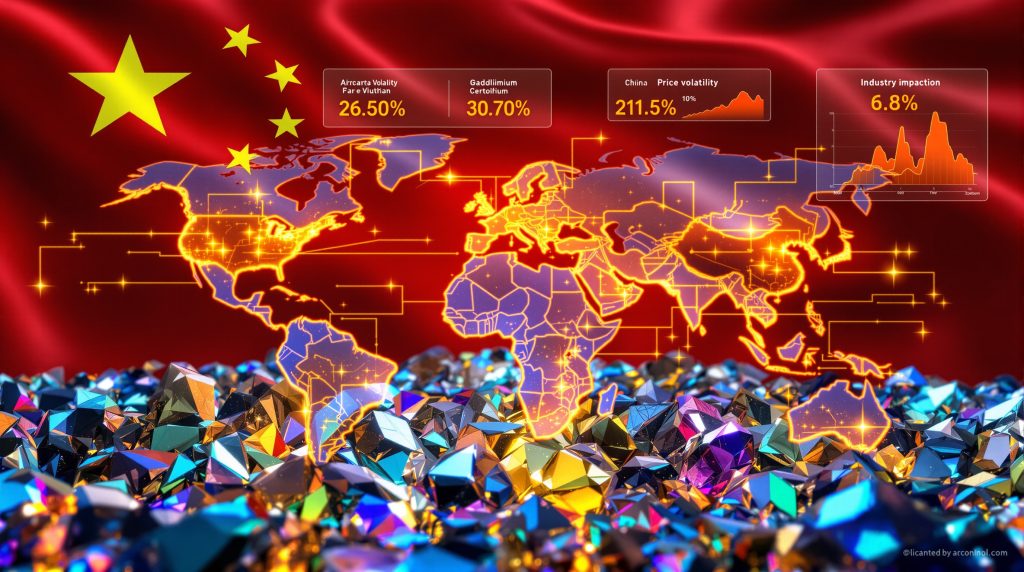Understanding China's Strategic Rare Earth Export Controls
China's implementation of comprehensive rare earth export licensing requirements represents a fundamental shift in global critical mineral governance. These China rare earth export controls, announced on October 9, 2025, require international exporters to obtain permits for shipments containing even trace amounts of specified Chinese minerals, extending Beijing's regulatory authority far beyond its borders.
The measures demand that even foreign exporters secure permits to ship products anywhere globally that contain traces of certain Chinese minerals, marking an unprecedented expansion of extraterritorial jurisdiction in commodity trade. Furthermore, this development underscores the growing importance of critical minerals energy security in global geopolitical strategies.
The Scope of Current Export Restrictions
The licensing framework encompasses seven critical rare earth elements: scandium, yttrium, samarium, gadolinium, terbium, dysprosium, and lutetium. This regulatory structure extends beyond traditional export controls by requiring permits for any global shipment containing these materials, regardless of the final destination or origin of processing.
Unlike conventional export restrictions that focus on direct bilateral trade, these controls create a web of compliance requirements affecting global supply chains. Companies worldwide must now navigate Chinese regulatory approval processes for international trade operations involving these strategic materials, even when China is not directly involved in the transaction.
Global Jurisdiction and Enforcement Mechanisms
China's approach mirrors long-arm jurisdiction principles previously employed by the United States, which Beijing once criticised. The extraterritorial application means companies conducting business between third countries must still comply with Chinese licensing requirements if their products contain specified rare earth elements.
Christopher Beddor, Deputy China Research Director at Gavekal Dragonomics, noted that managing the paperwork volume for global rare earth licensing presents significant administrative burdens for Chinese regulatory agencies. This complexity may result in selective enforcement targeting specific countries or companies rather than comprehensive global application.
How Do China's Controls Impact Global Supply Chains?
The rare earth licensing system creates unprecedented disruptions across multiple industrial sectors, fundamentally altering how companies approach supply chain planning and risk management. Manufacturing operations that previously operated without considering Chinese regulatory requirements now face complex compliance frameworks.
Manufacturing Sector Vulnerabilities
| Industry Sector | Primary Applications | Supply Chain Risk Level | Key Dependencies |
|---|---|---|---|
| Automotive | Electric vehicle motors, catalysts, battery components | High | Neodymium magnets, lanthanum |
| Electronics | Smartphone components, semiconductors, displays | Critical | Yttrium, europium, terbium |
| Defence | Precision-guided munitions, radar systems, communications | Strategic | Samarium, dysprosium, gadolinium |
| Renewable Energy | Wind turbine magnets, solar panels, energy storage | Severe | Neodymium, praseodymium, dysprosium |
| Aerospace | Navigation systems, advanced alloys, satellite components | Critical | Scandium, lutetium, yttrium |
U.S. Trade Representative Jamieson Greer warned about the expansive scope of the controls, emphasising that they could impact everything from artificial intelligence systems to household appliances. He specifically cited potential disruptions to smartphone trade between South Korea and Australia, as well as U.S.-manufactured cars being shipped to Mexico.
Price Volatility and Market Disruptions
Rare earth magnet exports have experienced dramatic declines, triggering price surges across European and North American markets. The uncertainty has created significant cost pressures for manufacturers, particularly in the electric vehicle sector where rare earth permanent magnets are essential for motor efficiency.
Consequently, automotive manufacturers report substantial cost increases for electric vehicle production, while electronics companies face extended lead times for critical components. The disruption extends beyond immediate supply concerns to fundamental questions about long-term sourcing strategies.
What Drives China's Strategic Rare Earth Policy?
Beijing's approach to rare earth governance reflects broader geopolitical objectives, leveraging its dominant market position to influence international trade relationships and diplomatic negotiations. The timing and scope of these controls demonstrate China's willingness to use economic tools as instruments of foreign policy.
Market Dominance as Geopolitical Leverage
China controls approximately 60% of global rare earth mining operations and over 85% of processing capabilities, creating a concentration that enables Beijing to use supply chain access as a diplomatic tool. This dominance extends beyond raw material extraction to the complex refining processes that transform rare earth ores into usable industrial materials.
Wu Xinbo, Director at Fudan University's Center for American Studies in Shanghai, characterised the export controls as providing China with increased leverage to prevent U.S. allies from supporting American pressure campaigns. He suggested that nations maintaining positive trade relations with Beijing and avoiding participation in U.S. sanctions against China would not be targeted by the new export controls.
Response to Western Technology Restrictions
The export controls represent China's strategic response to semiconductor export restrictions and technology transfer limitations imposed by the United States and allied nations. This reciprocal approach demonstrates how critical mineral access can serve as economic counterpressure in broader technological competition.
Beijing's adoption of long-arm jurisdiction principles it previously criticised reveals a pragmatic shift in Chinese trade policy. The legal framework underlying these controls has been under development for years, suggesting removal is unlikely regardless of near-term diplomatic negotiations. Moreover, these developments coincide with the China rare earth tariffs affecting global market dynamics.
Which Countries Are Building Alternative Supply Chains?
International efforts to reduce rare earth dependency on China have accelerated significantly, with major economies investing in domestic production capabilities and alternative sourcing arrangements. The urgency of these diversification efforts reflects growing recognition of strategic vulnerabilities in critical mineral supply chains.
United States Diversification Strategy
The Trump administration has committed $400 million in equity investment to MP Materials Corp for domestic rare earth magnet production, representing the largest federal investment in rare earth capabilities in decades. Additionally, the U.S. acquired a 10% stake in Canadian firm Trilogy Metals Inc, demonstrating government willingness to support strategic mineral independence through direct equity participation.
The US mineral production order highlights the administration's commitment to reducing foreign dependency in strategic resources. U.S. Trade Representative Jamieson Greer emphasised the objective of achieving domestic rare earth obtaining capability, stating in a Fox Business interview that the administration prefers private sector solutions but will provide public support when necessary.
The administration indicated it was possible the U.S. could take stakes in additional rare earth companies to increase mineral access, signalling an expanded role for government investment in strategic sectors.
Allied Nation Coordination Efforts
Treasury Secretary Scott Bessent revealed emerging coalition efforts, indicating U.S. officials were coordinating with European allies, Australia, Canada, India and Asian democracies to formulate a comprehensive response. This multilateral approach represents a significant shift from previous unilateral trade strategies.
Japan's Finance Minister Katsunobu Kato called for Group of Seven countries to unite and respond to China's rare earth export controls, while Germany promoted joint European Union initiatives. These coordinated efforts suggest unprecedented alignment among traditionally independent trade policies.
Australia's Prime Minister is negotiating critical mineral supply agreements with Washington to establish alternative trade partnerships, demonstrating how China's controls are accelerating bilateral cooperation on strategic resources.
European Union Response Mechanisms
The EU is considering mandatory technology transfer requirements for Chinese firms operating within European markets, representing a direct challenge to Chinese business operations in Europe. This approach mirrors tactics previously employed by China in requiring foreign companies to share technology for market access.
The Netherlands seized control of Chinese semiconductor company Nexperia after the U.S. warned the chipmaker would need to replace its Chinese CEO to avoid American blacklist inclusion. This action demonstrates European willingness to assert sovereignty over strategic assets when forced to choose between Chinese and American alignment.
How Effective Are China's Rare Earth Controls?
The success of China's export restrictions depends on multiple factors, including enforcement capabilities, economic interdependence, and international response coordination. Early analysis suggests mixed effectiveness due to implementation challenges and economic constraints.
Administrative Challenges and Implementation
Managing comprehensive global licensing for rare earth-containing products presents enormous administrative burdens for Chinese regulatory agencies. The complexity of tracking and approving shipments across diverse international supply chains may exceed practical enforcement capabilities.
Christopher Beddor suggested that administrative limitations could result in selective enforcement, with measures applied primarily when China wants to pressure particular partners rather than comprehensive global restriction. This selective approach would reduce the controls' broad economic impact while maintaining their value as diplomatic tools.
Economic Interdependence Limitations
Alicia Garcia Herrero, Chief Asia Pacific Economist at Natixis, noted that China's manufacturing sector relies heavily on healthy global demand for its rare earth products. Overly restrictive policies risk damaging the domestic industry that Beijing seeks to protect, creating natural limits on control effectiveness.
The interdependence creates a delicate balance for Chinese policymakers between maximising geopolitical leverage and maintaining industrial revenue streams. Extended disruption of global supply chains could ultimately harm Chinese producers more than intended targets.
What Are the Long-Term Implications for Global Trade?
China's rare earth export controls may catalyse fundamental changes in international trade relationships, supply chain strategies, and critical mineral governance frameworks. The precedent established by these measures extends beyond rare earths to broader questions of economic sovereignty and strategic resource control.
Accelerated Supply Chain Diversification
Countries previously comfortable with Chinese rare earth dependence are now actively developing alternative sources. This diversification extends beyond rare earths to other strategic materials where China maintains dominant market positions, potentially triggering comprehensive supply chain reconfigurations.
Alicia Garcia Herrero identified a cascade risk where diversification efforts could extend to multiple sectors where China dominates, creating substantial cumulative losses for Chinese industries. Once countries reconsider rare earth supply strategies, they may apply similar logic to solar panels, batteries, pharmaceuticals, and other Chinese-dominated sectors.
Technology Transfer and Investment Patterns
International investment flows are shifting toward rare earth projects outside China, with governments providing financial support for domestic production capabilities. This trend may permanently alter global critical mineral supply geography, reducing China's leverage over strategic materials.
Scott Kennedy, Senior Adviser at the Center for Strategic and International Studies, warned that continued economic weaponisation by both the U.S. and China could alienate the international community. This could prompt other nations to rebuild rules-based trading systems without either superpower's leadership, fundamentally reshaping global commerce.
The US-China trade war impact continues to influence global market dynamics and investment decisions. In addition, this reflects the broader mining industry evolution as geopolitical tensions reshape traditional supply chains.
How Are Markets Responding to Supply Uncertainty?
Financial markets and commodity traders are adapting to increased volatility and supply chain risks associated with rare earth export controls. Market responses reveal deep concerns about long-term supply security and pricing stability.
Price Discovery and Risk Premiums
Rare earth prices now incorporate significant geopolitical risk premiums, reflecting market uncertainty about future supply availability. This pricing structure affects downstream industries' cost calculations and investment decisions, with manufacturers forced to account for potential supply disruptions in their financial planning.
The uncertainty extends beyond immediate price impacts to fundamental questions about contract reliability and long-term sourcing agreements. Companies that previously relied on stable Chinese supply are reassessing their risk management frameworks.
Strategic Stockpiling and Inventory Management
Companies are increasing rare earth inventory levels to buffer against potential supply disruptions, while governments consider strategic reserve programmes similar to petroleum stockpiles. These inventory buildups create additional demand pressure on already constrained markets.
The shift toward strategic stockpiling represents a fundamental change in rare earth market dynamics, with security considerations increasingly outweighing traditional cost optimisation approaches. However, this trend requires significant capital investment and sophisticated inventory management systems.
What Role Do Rare Earths Play in Future Technology?
Understanding rare earth applications in emerging technologies helps explain why export controls generate such significant international concern and response. The elements' unique magnetic, optical, and catalytic properties make them difficult to substitute in high-performance applications.
Clean Energy Transition Dependencies
Wind turbines require approximately 200 kilograms of rare earth elements per megawatt of capacity, primarily neodymium and dysprosium for permanent magnet generators. Electric vehicle motors depend on rare earth permanent magnets for optimal efficiency and performance, with each vehicle containing 1-3 kilograms of rare earth elements.
The clean energy transition's dependence on rare earths creates strategic vulnerabilities for countries pursuing carbon neutrality goals. Solar panels, energy storage systems, and grid infrastructure all incorporate rare earth components essential for efficiency and reliability.
Defence and Aerospace Applications
Military applications for rare earths include precision-guided weapons systems, advanced radar technology, and satellite communication equipment. These strategic uses explain why defence departments prioritise supply chain security for these materials above cost considerations.
Modern fighter aircraft contain hundreds of kilograms of rare earth elements in guidance systems, electronic warfare equipment, and engine components. Disruption of rare earth supplies could impact defence readiness and military equipment production timelines.
How Can Companies Navigate Rare Earth Supply Risks?
Businesses dependent on rare earth elements must develop comprehensive risk management strategies to maintain operational continuity under evolving trade restrictions. The complexity of global supply chains requires multi-faceted approaches to supply security.
Supply Chain Diversification Strategies
Risk Mitigation Approaches:
-
Develop relationships with non-Chinese rare earth suppliers
-
Invest in recycling technologies to recover rare earths from waste products
-
Research alternative materials that can substitute for rare earth applications
-
Establish strategic inventory buffers for critical production inputs
-
Participate in industry consortiums for collective bargaining power
-
Engage government support programmes for strategic mineral independence
-
Implement supply chain transparency systems for regulatory compliance
Technology Innovation and Substitution
Companies are investing in research to reduce rare earth dependence through material science innovations, recycling improvements, and alternative technology development. These efforts aim to achieve similar performance characteristics using more abundant materials or reduced rare earth quantities.
Advanced recycling technologies can recover up to 95% of rare earth elements from end-of-life products, potentially creating closed-loop supply systems independent of primary mining. However, recycling infrastructure requires substantial initial investment and regulatory support.
Furthermore, collaborative research initiatives between universities and industry are accelerating the development of substitute materials. According to expert analysis of global supply chains, these technological advances could fundamentally alter rare earth demand patterns within the next decade.
Navigating the New Rare Earth Reality
China's rare earth export controls represent a permanent shift in critical mineral governance, requiring businesses and governments to fundamentally reconsider supply chain strategies. While short-term disruptions create operational challenges, these controls may ultimately accelerate global supply chain diversification and technological innovation that reduces dependence on any single supplier nation.
The administrative complexity of enforcing global licensing requirements may limit the controls' immediate effectiveness, but their psychological impact on market behaviour is already evident. Companies and governments are implementing supply security measures that will persist regardless of future policy changes.
The effectiveness of international coordination efforts will determine whether alternative supply chains can successfully challenge China's rare earth dominance. The unprecedented alignment between the United States, European Union, Japan, Australia, and other allies suggests a sustained commitment to supply chain diversification that could reshape global trade relationships for decades.
Disclaimer: This analysis is based on current information and market conditions as of October 2025. Rare earth markets are subject to rapid changes due to geopolitical developments, technological advances, and regulatory modifications. Companies should consult with supply chain experts and legal advisors when developing rare earth sourcing strategies.
The long-term implications extend beyond rare earths to broader questions of economic interdependence and strategic resource control, potentially establishing new frameworks for critical mineral governance in an increasingly multipolar world.
Want to Invest in the Next Rare Earth Discovery?
As geopolitical tensions reshape global mineral supply chains, Discovery Alert's proprietary Discovery IQ model delivers instant notifications on significant ASX rare earth and critical mineral discoveries, empowering subscribers to identify actionable opportunities ahead of the broader market. Explore Discovery Alert's dedicated discoveries page to understand why historic mineral discoveries can generate substantial returns, and begin your 30-day free trial today to position yourself ahead of evolving market dynamics.




